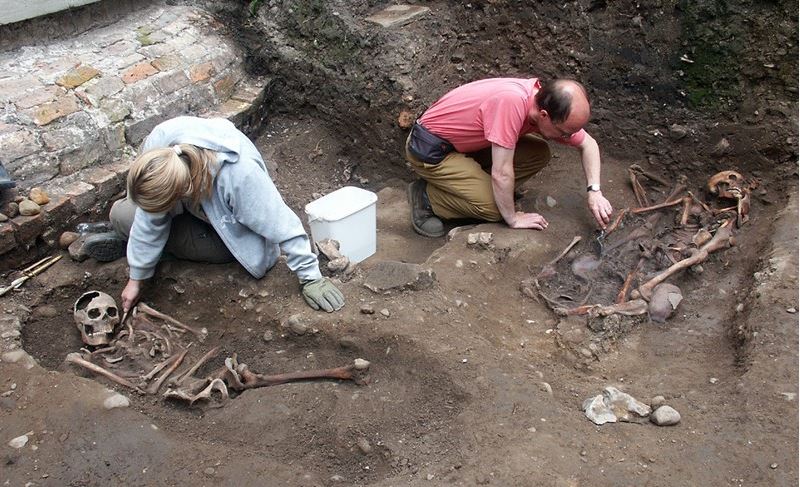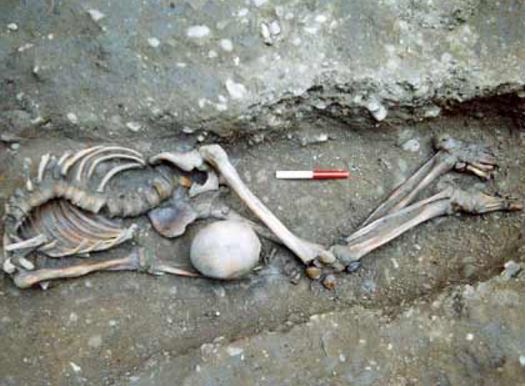The mystery of more than eighty Roman age decapitated bodies discovered in York is gradually unravelling, thanks to cutting edge genome technology. The mystery has baffled archaeologists – who wondered whether they were skeletons of criminals, soldiers or perhaps gladiators, and where they came from – for over a decade.
Scientists are still uncertain whether they were gladiators or soldiers, but we now have a much better idea of where they came from.
Archaeologists from the University of York, together with colleagues from other centres in the UK, Ireland and the Netherlands, exploited the origins of a set of Roman-age decapitated bodies – discovered at Driffield Terrace in the City of York by the York Archaeological Trust – and found they included a body from the Middle East alongside native Europeans.
The researchers published details of their research in the academic journal Nature Communications.
 From 2004-5, archaeologists excavated eighty burials at Driffield Terrace in York. According to the York Archaeological Trust: “The male skeletons displayed deliberate trauma, interesting pathology and peri-mortem decapitation.” (Image: yorkarchaeology.co.uk)
From 2004-5, archaeologists excavated eighty burials at Driffield Terrace in York. According to the York Archaeological Trust: “The male skeletons displayed deliberate trauma, interesting pathology and peri-mortem decapitation.” (Image: yorkarchaeology.co.uk)
Many of the bodies had suffered perimortem (at or near time of death) decapitation. They were all under forty-five years of age. Although their heads were buried with their bodies, they were oddly positioned – some were within their legs, on their chest, while others were at their feet.
Genomic analysis revealed where the men came from
Although examining the skeletons told the scientists something about their lives, including injuries they must have suffered in battle, and childhood deprivation, it was the pioneering genomic analysis that helped the team members piece together the origins of the men.
The skeletons of seven of the more than 80 individuals were selected for whole genome analyses. Despite differences in isotope values, which suggested that some of the men had lived outside Britain, the majority had genomes that were similar to an earlier Iron Age adult female from Melton, East Yorkshire.
Given that the men had suffered poor health during infancy, they were probably from disadvantaged households. However, their robust skeletons and healed injuries indicated that they were accustomed to wielding heavy weapons.
Surprisingly, the closest modern descendants of these Roman Britons live in Wales, and not Yorkshire.
Study revealed impact of migrations
They also studied the skeleton of an adult male from a Christian Anglo-Saxon cemetery in the village of Norton, Stockton-on-Tees, Durham. His genes were found to be more closely aligned to modern East Anglia and people from the Netherlands, highlighting the impact of migrations which occurred later, on the genetic makeup of the earlier Roman British people.
 A decapitated Roman Briton who had been buried together with his head. The archaeologists were surprised to see that most of the headless bodies had been buried with their heads, but placed in odd positions. (Image: culture24.org.uk. Credit: York Archaeological Trust)
A decapitated Roman Briton who had been buried together with his head. The archaeologists were surprised to see that most of the headless bodies had been buried with their heads, but placed in odd positions. (Image: culture24.org.uk. Credit: York Archaeological Trust)
The Roman burial samples were all adult males, under 45 years of age, and most had evidence of decapitation. They were taller that average Roman Britons at the time, and displayed evidence of significant trauma, probably caused by man-to-man combat.
They all, except one, had brown eyes and black or brown hair. One of them had distinctive blue eyes and blond hair, similar to the single Anglo-Saxon male.
Northern edge of Roman empire was cosmopolitan
The York skeletons’ demographic profile resembles the population structure in a Roman burial site believed to be for gladiators at Ephesus, an ancient city in Turkey’s Central Aegean region.
However, they might have been soldiers. There was a minimum recruitment height in the Roman army, and fallen soldiers would match the age profile of those found at the York cemetery.
 This man had been buried with large, heavy iron rings around his ankles. This find is unique – a shackled burial such as this had never been found anywhere in the Roman world. (Image: YouTube)
This man had been buried with large, heavy iron rings around his ankles. This find is unique – a shackled burial such as this had never been found anywhere in the Roman world. (Image: YouTube)
Co-author and coordinator of the scientific analysis, Professor Matthew Collins, of the BioArCh research facility in the Department of Archaeology at York, said:
“Whichever the identity of the enigmatic headless Romans from York, our sample of the genomes of seven of them, when combined with isotopic evidence, indicate six to be of British origin and one to have origins in the Middle East. It confirms the cosmopolitan character of the Roman Empire even at its most northerly extent.”
“This is the first refined genomic evidence for far-reaching ancient mobility and also the first snapshot of British genomes in the early centuries AD, indicating continuity with an Iron Age sample before the migrations of the Anglo-Saxon period.”
Citation: “Genomic signals of migration and continuity in Britain before the Anglo-Saxons,” Rui Martiniano, Anwen Caffell, Ian Barnes, Malin Holst, Kurt Hunter-Mann, Janet Montgomery, Colleen Morgan, Gundula Müldner, Russell L. McLaughlin, Orla Hardiman, Matthew D. Teasdale, Leonard H. van den Berg, Wouter van Rheenen, Jan H. Veldink, Maureen Carroll, Steve Roskams, John Oxley, Daniel G. Bradley, Mark G. Thomas, Christine McDonnell & Matthew J. Collins. Nature Communications 7, Article number: 10326. DOI:10.1038/ncomms10326.
Video – The Mystery of the Headless Romans
